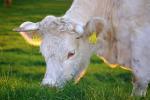H2020 GALIRUMI Project: Galileo-assisted robot to combat the Rumex obtusifolius weed and increase the profitability and sustainability of dairy farming
- Type Project
- Status Filled
- Execution 2019 -2023
- Assigned Budget 1.224.742,5 €
- Scope Europeo
- Main source of financing Horizon 2020
- Project website GALIRUMI
Dairy farmers are constantly seeking long-term solutions to control persistent weeds in pastures. While herbicides are effective, they also contaminate soil, water, food, and air. The EU-funded GALIRUMI project will develop a weeding robot for herbicide-free weed control in dairy farming.
By eliminating the use of herbicides, dairy farmers will be able to adopt organic farming. The project will develop and demonstrate this new weed control technology, which uses autonomous vehicles, computer vision, and robots as a service for precision dairy farming, based on precise navigation provided by the European Global Navigation Satellite System (GGS).
Agriculture provides humans with the necessary food and raw materials, but its environmental impact is unacceptably high. Many efforts are being made to make agriculture more sustainable, for example through precision agriculture or organic farming. Throughout agriculture, weed control is a major issue. Weed control with herbicides has a major environmental impact. Manual weed control involves exhausting labor, high labor costs, and difficulties in finding sufficient labor. GALIRUMI's primary objective is to offer robotic weeding for herbicide-free weed control on dairy farms. Robotic weeding will reduce the environmental impact of dairy farming by eliminating herbicide use and reducing farm workers' exposure to herbicides. It will also remove a major obstacle for dairy farmers to convert to organic production, thus contributing to an increase in the production of organically produced milk and higher incomes for farmers. GALIRUMI will develop and demonstrate a series of innovative technologies in weed detection, weed degradation, autonomous vehicles, and robots as a service for precision dairy farming based on precise navigation provided by EGNSS.
Several areas of expertise are needed for the successful development of practical robotic weeding:
- EGNSS • Computer vision for weed detection.
- Construction of agricultural machinery.
- Provision of services to farmers.
- Weed Science.
- Dairy research.
The robotic weeding control system is the final product that GALIRUMI intends to implement and commercialize, proposed by dock weeding as a service through:
- Laser defoliation system using a small robot that requires frequent application in the field.
- A medium-sized robotic system with an electrocution tool that requires field application in a single season. GALIRUMI will significantly reduce labor for weeding, the cost of weed management, damage to pastures from herbicide application, the impact of dairy farming on the environment, and discomfort to dairy cows.
Satellite navigation enables weed control without herbicides. Satellite-guided autonomous robots can perform weeding tasks with precision, helping farmers reduce herbicide use and eliminating the need for backbreaking manual labor. While agriculture provides essential food and raw materials, the environmental impact remains unacceptably high. This has led to concerted efforts to make the sector more sustainable. "In all aspects of agriculture, controlling weeds is a major issue," notes Esther López, GALIRUMI project coordinator at ACORDE Technologies in Spain. "However, weed control with herbicides is harmful to the environment, while manual weed control involves backbreaking work and high labor costs."
The EU-funded GALIRUMI project sought to develop an innovative new weeding method that overcomes both of these drawbacks. The project's solution was to apply robotics to provide herbicide-free weed control on dairy farms, particularly for broadleaf sorrel. "Robotic weeding not only eliminates the use of herbicides but also reduces farmworkers' exposure to them," says López. "This approach can also contribute to the growth of organic farming." Using precise satellite navigation.
The project team began by examining various innovative technologies for weed detection and degradation, as well as for autonomous vehicles. All of this was based on the precise navigation provided by the European Global Navigation Satellite System (EGNSS). The technologies investigated included computer vision for weed detection, as well as laser and electric weeding systems. The project consortium included experts in weed and dairy research, as well as technology specialists. “We involved end-users from the beginning,” notes López. “They provided us with specific requirements and operational scenarios, which contributed to the design and development of the robotic systems.” The completed robots incorporate EGNSS modules with dual-antenna configurations, camera systems for weed detection, and a central processing unit. The dual EGNSS antenna provides precise directional information to the robot’s navigation module.
An economic feasibility assessment of the robotic weeding solution was also conducted. Autonomous Weeding Demonstrations The robot prototypes were subsequently tested on dairy farms, focusing on broadleaf weeds. Two types of robotic weeding units were developed: one for laser weeding and the other for electrocution weeding. "We were able to demonstrate how the robot follows a predefined route through the field," explains López. "When it detects a specific weed, the robot can deviate and navigate to the coordinates of the detected plant." The robot stops over the weed and activates the laser or electrocution function. Upon completion of weeding, the robot returns to the predefined route and searches for more plants. By assisting farmers with weeding tasks, López believes the laser robot is closer to commercialization.
The weeding unit is independent of the vehicle, and the vehicle is light enough not to damage the lawn along the way. More work will be needed to commercialize the electric weeder. "We are still identifying some commercial aspects and trying to better understand the economic concerns of farmers and future users," adds López. "However, we have been able to demonstrate that an autonomous weeding robot, with the support of EGNSS, can assist farmers in their weeding tasks." In this way, López believes the project can significantly contribute to organic production, eliminating the need for herbicides and labor, and generally contributing to environmental protection.
- ACORDE TECHNOLOGIES SA (ACORDE)







